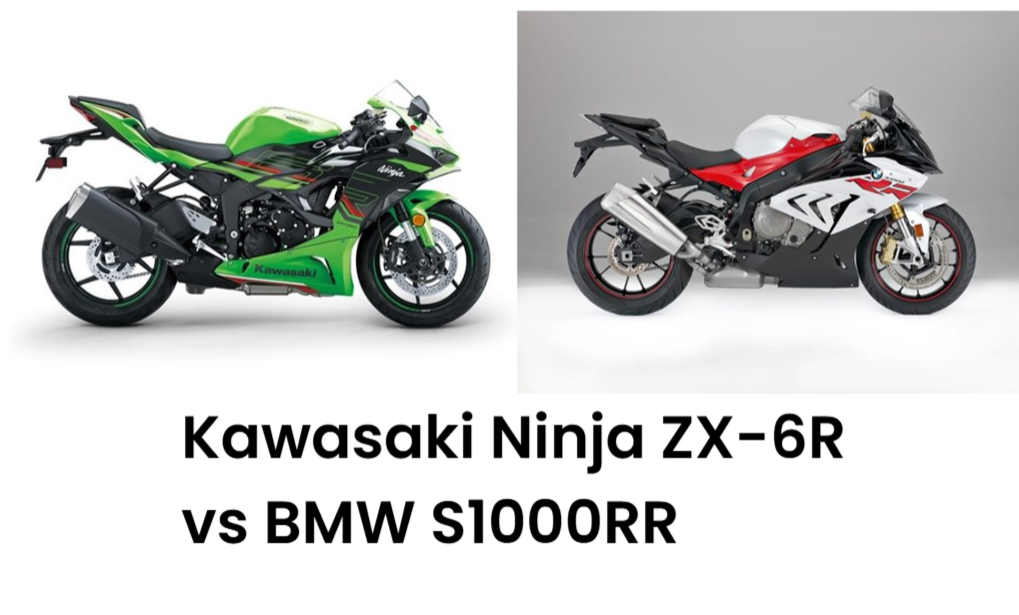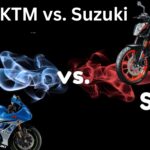Are you ready to step into the world of high-tech sportbikes? The Kawasaki Ninja ZX-6R and BMW S1000RR are two of the most advanced motorcycles available today. These machines boast breathtaking speed and are packed with state-of-the-art technology. These bikes change how we ride. They offer safety-focused electronic aids and smart connectivity features. Let’s take a closer look at their technological advancements and see how they stack up against each other.
The Battle of Tech Titans: Kawasaki vs. BMW
Kawasaki and BMW have long been at the forefront of motorcycle innovation. In this comparison, we’ll look at two top sportbikes: the Kawasaki Ninja ZX-6R and the BMW S1000RR. We’ll focus on their tech features, electronic assistance systems, and connectivity options. By breaking down these aspects, we’ll highlight the strengths of each bike and help you decide which one suits your riding needs best.
Cutting-Edge Technology at the Core
The Kawasaki Ninja ZX-6R and BMW S1000RR use advanced technology. This improves performance, safety, and the riding experience. These motorcycles have high-tech onboard computers, multifunctional displays, and advanced security features. They show off the engineering excellence of their manufacturers.
Electronic Aids for Enhanced Control
Modern sportbikes come with electronic rider aids designed to improve control and confidence. The Ninja ZX-6R has advanced launch control. The BMW S1000RR comes with an electronically adjustable suspension system. Both bikes use smart tech to improve power delivery and stability. This makes riding at high speeds safer and more controlled.
Smart Connectivity for the Modern Rider
Smartphone integration is now standard in high-end motorcycles. These two bikes offer great connectivity options. The Ninja ZX-6R and S1000RR show what the future of motorcycle tech looks like. You can sync routes, control music, or take calls while riding.
Security Features for a Safer Ride
Security is a priority for both manufacturers. Kawasaki’s Intelligent Anti-lock Brake System (KIBS) provides controlled braking. Also, BMW’s Automatic Stability Control (ASC) boosts traction and stability. These features help riders maintain confidence in various road conditions.
Kawasaki Ninja ZX-6R: A Deep Dive into Its Tech Features
The Ninja ZX-6R is more than just a high-speed machine; it’s engineered to provide a perfect blend of power, control, and innovation. Let’s explore its standout technological features:
Engine Control Unit (ECU): The Bike’s Brain
The Ninja ZX-6R’s ECU adjusts fuel delivery and ignition timing. This improves performance and fuel efficiency. This ensures a thrilling ride without excessive fuel consumption.
Advanced ABS for Enhanced Braking
The Kawasaki Intelligent anti-lock Brake System (KIBS) stops wheel lock-up when you brake hard. This boosts safety and makes your response time better in emergencies.
Traction Control for Maximum Stability
Kawasaki’s Traction Control System (TCS) keeps an eye on wheel speed and throttle input. It helps improve traction, lowering the chances of losing control on slippery roads or when accelerating hard.
Quick Shift System for Seamless Gear Changes
The Quick Shift System (KQS) enables smooth, clutchless gear shifts. This makes high-speed riding easier and cuts down on rider fatigue.
Assist & Slipper Clutch for Smooth Transitions
The assist and slipper clutch makes the clutch lever easier to pull. It helps you shift smoothly and stops wheel hop during quick downshifts.
BMW S1000RR: A High-Tech Masterpiece
The BMW S1000RR is an engineering wonder. It features advanced technology that boosts performance and safety. Here’s a closer look at its standout features:
Dynamic ECU for Intelligent Performance
The BMW S1000RR’s ECU adjusts ignition timing and fuel injection. It optimizes performance based on real-time riding conditions. This ensures smooth power delivery.
ABS Pro: Braking Confidence in Any Situation
BMW’s ABS Pro system boosts safety, especially in corners. It stops wheel lock-ups and helps with stable, controlled braking.
Dynamic Traction Control (D-TC) for Ultimate Grip
The S1000RR’s D-TC looks at lean angle, speed, and road conditions. It adjusts power delivery to balance safety and high-speed performance.
Gear Shift Assist Pro for Faster Shifts
BMW’s Gear Shift Assist Pro lets you shift gears without using the clutch. This means you can accelerate smoothly and change gears easily.
Dynamic Electronic Suspension Adjustment (ESA)
This system automatically changes suspension settings in real time. It finds the right balance between comfort and performance, depending on road conditions.
Comparing Electronic Aids: Kawasaki Ninja ZX-6R vs. BMW S1000RR
Stability and Traction Control
- The Kawasaki Ninja ZX-6R has three traction control modes. These modes adjust to various riding conditions. This feature helps maintain stability, especially at high speeds.
- The BMW S1000RR’s D-TC is more advanced, dynamically adjusting power delivery based on real-time lean angle and road grip.
Gear Shifting Technology
- Kawasaki’s Quick Shift System (KQS) allows seamless upshifting without using the clutch.
- BMW’s Gear Shift Assist Pro allows clutchless upshifts and downshifts. This feature gives you a smoother and more precise shifting experience.
Braking Safety Features
- The Ninja ZX-6R’s KIBS optimizes braking force distribution, reducing the risk of skidding.
- The BMW S1000RR’s ABS Pro provides enhanced braking safety, especially when cornering at high speeds.
Smart Connectivity and Navigation
Smartphone Integration
- The Kawasaki Ninja ZX-6R connects via the Rideology app, allowing riders to access vehicle data, ride logs, and more.
- The BMW S1000RR uses the BMW Motorrad Connected App. This app provides GPS navigation, ride stats, and easy smartphone integration.
GPS Navigation
- Both bikes come with built-in GPS features, ensuring riders never lose their way.
- BMW goes further by adding GPS navigation to the TFT display. This makes it easier to get route guidance.
Display and On-Board Computers
Kawasaki Ninja ZX-6R: Intuitive Display and Customization
The ZX-6R has a clear LCD screen. It shows real-time data like fuel levels, speed, and ride stats. It also offers customizable settings for power modes, traction control, and ABS tuning.
BMW S1000RR: High-Tech Multi-Function TFT Display
The BMW S1000RR boasts a 6.5-inch TFT display that delivers critical ride information in an easy-to-read format. The system also integrates smartphone notifications, music controls, and turn-by-turn navigation.
High-End Performance Meets High-Tech: The Engine Technology of Kawasaki Ninja ZX-6R and BMW S1000RR
Beneath the sleek designs of the Kawasaki Ninja ZX-6R and BMW S1000RR is powerful engine technology. This tech drives these bikes to the top of motorcycling innovation.
These motorcycles offer high performance and use cutting-edge technology. This revolutionizes engine operations and delivers maximum power, efficiency, and reliability. Discerning riders really value these features.
Let’s delve into the engine technology involved.
Engine Innovation: More Than Just Horsepower
Both the Kawasaki Ninja ZX-6R and BMW S1000RR feature finely tuned engines. These engines are built for speed, performance, and durability.
Both bikes have engines made with advanced technologies. These technologies boost power and improve fuel efficiency. Inline-four engines are common in these sportbikes. They provide a good mix of power and control that riders around the world appreciate.
Combustion Efficiency: Masterful Performance Meets Prudent Fuel Economy
Both motorbikes employ sophisticated fuel injection systems to boost combustion efficiency. Kawasaki uses Dual Throttle Valves technology. This helps create a better fuel-air mix for optimal combustion. On the other hand, BMW has a smart fuel injection system. It tracks and adjusts fuel supply, ensuring maximum efficiency.
Both provide strong performance and good fuel economy, which is key in today’s eco-friendly world.
Cooling Systems: Managing the Heat of High Performance
High-performance engines produce a lot of heat. So, managing this heat well is vital for keeping the engine healthy and performing at its best. Both Kawasaki and BMW deploy liquid cooling systems for temperature control. This improves the bikes’ reliability and lifespan by stopping overheating. This way, you get great performance ride after ride.
Engine Management Systems: Optimizing Performance for Every Ride
From Kawasaki’s ECU to BMW’s BMS-X, these bikes’ engine management systems showcase technological expertise.
This technology monitors and controls engine functions. It ensures the best output, from ignition timing to valve operation, no matter the riding conditions.
Embedded sensor systems send data to the processor. This helps manage engine parameters and ensures optimal performance each time.
Kawasaki vs. BMW: Who Has the Better Security Features?
High-tech motorcycles like the Kawasaki Ninja ZX-6R and BMW S1000RR have advanced security features that we should not overlook.
Both bikes come with the latest technology. They have great security features that protect the motorcycles and improve rider safety. Let’s compare and contrast these features.
Anti-Theft Protection
One significant aspect of motorcycle security is protection against theft. Both Kawasaki Ninja ZX-6R and BMW S1000RR go beyond the traditional mechanical locks or immobilizers.
The Kawasaki Ninja ZX-6R includes an ignition switch that doubles as a steering lock, deterring would-be thieves. The BMW S1000RR offers an optional anti-theft alarm system. This alerts you if the bike is moved or tampered with. It gives you peace of mind when the bike is left unattended.
Brake Locks for Additional Security
Brake locks can be a convenient and efficient tool to provide an additional layer of security, and both the Ninja and the BMW offer this feature.
Kawasaki supplies an optional disc lock with an integrated alarm system for the Ninja ZX-6R. BMW equips the S1000RR with an automatic brake disc recognition system. This system works with the brake disc lock, boosting overall security.
Riding Safety
The Ninja ZX-6R comes with a safety package. It has a cornering management function, intelligent ABS, and a three-mode traction control system. This setup gives the rider a safe and stable ride on different road conditions. The S1000RR features ABS Pro, Dynamic Traction Control, and Dynamic Damping Control. These systems ensure secure and stable riding on sharp corners and high-speed straights.
Advancements in Suspension and Braking: A Look into Kawasaki Ninja ZX-6R and BMW S1000RR
As you start your journey with the Kawasaki Ninja ZX-6R or the BMW S1000RR, know that both bikes are designed for great ride quality and safety.
Suspension Technology
Both the Kawasaki Ninja ZX-6R and the BMW S1000RR exhibit ground-breaking suspension technology.
The ZX-6R features a Showa Balance Free Fork and a fully adjustable rear monoshock. The S1000RR stands out with its Dynamic Damping Control (DDC) system, which offers adaptive suspension.
These advanced suspension systems give better control, comfort, and ride quality on different terrains.
Braking Systems: Combining Safety & Performance
The ZX-6R has dual 310mm semi-floating petal discs in front and a single 220mm petal disc at the back. It also comes with a high-tech anti-lock braking system.
On the other hand, the S1000RR sports twin 320mm discs upfront and a single 220mm disc on the rear, supported by its superior ABS Pro system. The end result? Powerful, responsive braking that elevates both safety and performance.
Comparing the Aerodynamics: Kawasaki Ninja ZX-6R vs. BMW S1000RR
Both bikes employ advanced aerodynamic designs to improve speed, maneuverability, and fuel efficiency.
The Ninja ZX-6R has sharp, aggressive bodywork. This design, inspired by the Ninja ZX-10R, directs wind well. It helps reduce drag and improves stability at high speeds.
The BMW S1000RR features a lighter and more compact design. It has fairings, winglets, and gills placed just right. This design helps it cut through the wind and stay stable at high speeds.
Conclusion
The Kawasaki Ninja ZX-6R and BMW S1000RR come with impressive tech features, electronic aids, and connectivity options. They provide riders with many features. These include high-performance engine control units, ABS systems, traction control, and advanced GPS. All these help improve the riding experience. They each have their unique strengths and are tailored for different riding preferences.
Regardless of your choice, you will be getting a bike that pushes the boundaries of what’s possible in motorcycle technology. These two powerhouses truly showcase the strides we’ve made in integrating tech into our rides. Ride with confidence and experience cutting-edge features with the ZX-6R or S1000RR.






